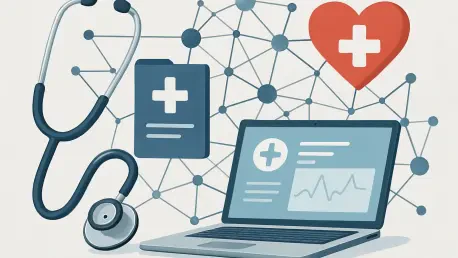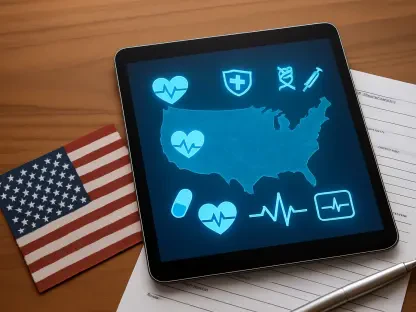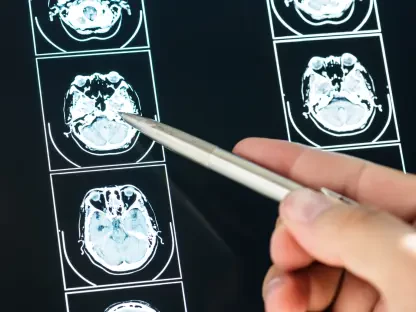In an era where healthcare systems often grapple with fragmented data and inefficient workflows, a significant shift is underway to bridge these gaps through innovative technology. Imagine a patient seamlessly accessing their complete medical history from multiple providers in one place, or a clinician receiving real-time updates from a patient’s home health device during a critical moment. This vision of connected care is becoming a reality through the efforts of Epic, a leading electronic health record (EHR) provider. Their recent developer conference, focused on advancing data interoperability, showcased groundbreaking tools and strategies aimed at transforming how health information is shared and utilized. By prioritizing patient empowerment, developer enablement, and industry collaboration, Epic is paving the way for a more integrated healthcare ecosystem. This article delves into the key initiatives and innovations driving this change, exploring how they address longstanding challenges and set new standards for connectivity in healthcare.
Empowering Patients with Seamless Data Access
One of the most transformative aspects of Epic’s approach lies in enhancing patient access to their health data. The upcoming rollout of MyChart Central, expected later this year, promises to be a game-changer by allowing individuals to consolidate records from various healthcare organizations into a single, user-friendly account. This platform goes beyond mere aggregation, incorporating features like biometric login for security and the ability to share comprehensive medical information with trusted applications. Such advancements empower patients to take a more active role in managing their health, ensuring they have the full picture at their fingertips. Additionally, support for the Bluetooth Generic Health Sensor specification means patients can directly connect home monitoring devices, such as blood pressure cuffs, to MyChart. This integration bridges personal health tracking with clinical oversight, fostering a more holistic approach to care that could significantly improve outcomes through timely data sharing.
Another critical facet of patient empowerment is the focus on usability and engagement within Epic’s tools. For instance, the planned introduction of real-time “blue dot” wayfinding in MyChart, set for release in November this year, aims to simplify navigation for patients within healthcare facilities. This feature addresses a common pain point—finding one’s way in often complex hospital environments—thereby reducing stress and improving the overall experience. Beyond navigation, Epic is also working on enabling patients to share nuanced data sets with providers and third-party apps, ensuring that critical information like advance directives is accessible when needed. These efforts reflect a broader commitment to not just providing data, but making it actionable and meaningful for patients. By prioritizing user-centric design and connectivity, Epic is redefining how individuals interact with their health information, setting a new benchmark for patient involvement in care delivery.
Enabling Developers with Robust Tools and Resources
Equally significant is Epic’s dedication to supporting app developers with cutting-edge resources that fuel innovation. The availability of the Clarity data model for licensing stands out as a pivotal move, offering developers access to population-level data crucial for building applications in AI, analytics, and population health management. This initiative lowers the barriers to creating impactful solutions that can address systemic healthcare challenges, from predicting disease outbreaks to optimizing resource allocation. Furthermore, Epic’s enhancements to the developer experience through platforms like Open.Epic and the Vendor Services program provide practical support, including a streamlined five-step guide for app creation and over 40 Developer Playbooks for common workflows. These tools, combined with expanded Sandbox testing capabilities, enable developers to experiment and refine their solutions with greater ease, fostering a vibrant ecosystem of healthcare applications.
Beyond foundational resources, Epic is also rolling out targeted APIs to meet specific needs within the industry. Looking ahead, the release of prior authorization APIs in early 2026 will streamline communication between providers and payers, reducing administrative burdens and accelerating care delivery. Similarly, the Staff Duress APIs, also slated for early 2026, will introduce location-aware safety alerts for healthcare staff, enhancing workplace security in high-stress environments. These forward-thinking tools demonstrate a keen understanding of real-time data’s value in improving both operational efficiency and safety. Feedback from partners integrating these solutions highlights their potential to transform care coordination and patient flow. By equipping developers with the means to build tailored, impactful applications, Epic is catalyzing innovation that directly benefits providers and patients alike, reinforcing its role as a leader in healthcare technology.
Driving Interoperability Through Collaboration and Standards
A cornerstone of Epic’s strategy is its push for interoperability through adherence to emerging standards and collaborative platforms. Support for frameworks like USCDI v5, which standardizes data exchange on critical topics such as diagnostic imaging, underscores a commitment to creating a unified language for health information across systems. This alignment with industry standards ensures that data can flow seamlessly between disparate organizations, addressing the longstanding issue of fragmented records. Moreover, Epic’s facilitation of over 745 billion data exchanges via public APIs in the past year illustrates the scale of their impact. Plans to expand these APIs further signal a sustained effort to enhance connectivity, ensuring that healthcare stakeholders can access and utilize information in real time to make informed decisions.
Collaboration remains at the heart of these interoperability efforts, as evidenced by events like the developer conference that united nearly 1,000 healthcare experts and app creators. This gathering fostered dialogue on shared goals, from improving clinical workflows to enhancing patient engagement. Initiatives like the revamped Showroom marketplace for Epic-connected apps, with improved search and organization features, further support this collaborative spirit by making it easier for organizations to discover and adopt innovative solutions. The emphasis on open data systems reflects a consensus among stakeholders that systemic challenges in healthcare can only be tackled through collective action. By acting as a facilitator of both technological and human connections, Epic is helping to build a more responsive and integrated healthcare landscape, where data serves as a unifying force rather than a barrier.
Building a Connected Future for Healthcare
Reflecting on the strides made during the recent developer conference, it’s evident that Epic played a pivotal role in uniting diverse perspectives around a common mission of enhancing healthcare through technology. The introduction of patient-focused tools like MyChart Central, alongside robust developer resources and a commitment to interoperability standards, marked significant progress in addressing fragmented data systems. These efforts not only tackled immediate needs, such as simplifying app integration, but also laid the groundwork for long-term advancements in care coordination. Looking ahead, stakeholders can build on this momentum by advocating for broader adoption of open platforms and standardized data practices. Exploring partnerships to integrate emerging technologies, like AI-driven analytics, could further amplify the impact of these initiatives. Ultimately, the path forward involves a collective commitment to leveraging connectivity to improve patient outcomes and streamline healthcare delivery.









